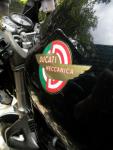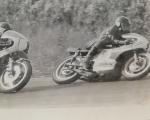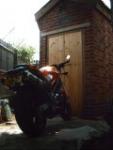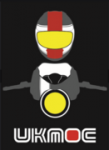Quote:
Originally Posted by 350TSS

...... when they were first fitted the disc calipers were heavy and being in front of the fork legs they were effectively outside the wheelbase and made tank slappers more pronounced and less likely to be recovered
|
I think this is due to their position relative to the steering axis rather than the wheelbase.
Front mounted calipers increase the polar inertia about the steering axis, like Darkness describes.
At something of a tangent (pun), I'm also thinking that front mounted calipers might lead to slightly less fork dive induced by the brake reaction .. but also that the effect would be tiny compared to the effect of weight transfer under braking.
This may have less practical relevance than other previously mentioned factors though.
No doubt the design of "upside down" forks greatly reduces leg flex, due not only to their bigger diameter these days but also to the greater proximity of the fork bushes to the wheel spindle .. and hence bracing across the mudguard mounts is less necessary.
On my old 1976 Honda TL trials bike, the mudguard mount brace was made out of spindly steel plate, only about 1mm thick.
On my 1996 Dommie trailie (also wth "old-style" forks), the brace is more like 3mm thick and much deeper too. It is massively more rigid.
When I first bought the Commando, it's fibreglass front mudguard was attached with jubilee clips to each fork leg (if I remember correctly). Not much bracing there then !!
I guess there may even be a case for saying that rear mounted calipers make front wheel removal easier .. a tiny point but one which I'm sure bike manufacturers will consider nevertheless.
"It's all linked though, innit ?"













 Roast Beef Monster!
Roast Beef Monster!




 Linear Mode
Linear Mode

